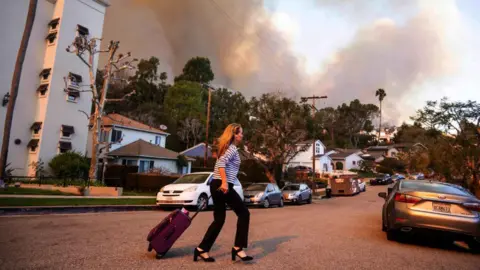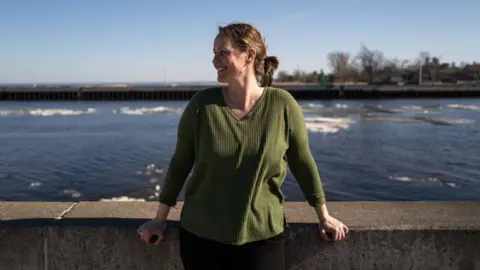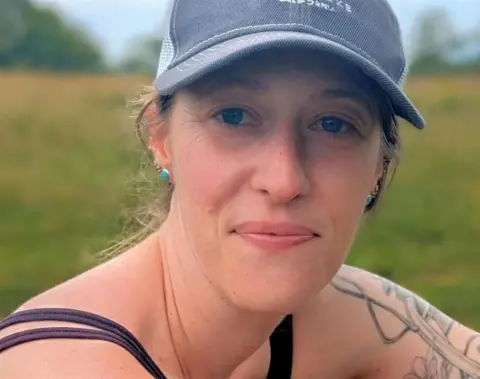 Gety pictures
Gety picturesChristina still remembers how the sky appeared on the day when the wild fires came two miles (3.2 km) from Santa Rosa, California, her home.
The 2017 Tubbs fire was the most destructive in the history of California at the time. She was awakened by Mrs. Wilsh’s neighbor in the morning, and told her to hold her property and exit. When Mrs. Wilsh opened the door, the ash was falling from the sky and filling the air smoke.
Then, in 2019, Kincade Wildfire forced her parents to evacuate for five days.
It was the final batch of Mrs. Wilsh. After advice from a friend, she mobilized her possessions and led the country to her new hometown: Dolmit, Minnesota.
“It was just a culmination of this,” said 42 -year -old. “There are so many times that I would have been ordering every fall of worrying about what would light the fire, if I would lose a house.”
Mrs. Wilsh is one of the many people who have left California in recent years due to climate disasters, even before he kills the most forest fires in the history of Los Angeles 25 people this month.
Only this week, a new, rapid, massive fire broke out in Los Angeles County, northwest of the city, forcing tens of thousands of people to evacuate an area already reeling from destruction. Trump plans to visit Southern California on Friday to see the destruction of fire.
Climate experts say yet, they have not seen mass migration from the state because of climate change – and it is difficult to estimate the number of people who left for this reason. However, the state’s population growth rate has continued to decline since 2000, according to the US census.
But demographic scientists and experts say that although climate change disasters become more extreme and unpredictable, the number of people who leave the state can rise, leaving some cities not ready for the task of welcoming the new population.
“There can be this wave of new people who say,” You know what? California will not succeed for me because this is the third time in five years that I had to close my doors due to extreme soot and a professor of data science at the University of Michigan Derek van Birkel, smoke. ”
“We have to start preparing for these possibilities, because they will become more frequent and more extreme.”
California leaving for “climatic havens”
 Gety pictures
Gety picturesA number of climate -related factors may push California to leave home over the next decade. From 2020 to 2023, forest fires destroyed more than 15,000 structures in California, according to Calfire. At least 12,000 buildings were lost in Los Angeles fires that erupted at the beginning of this year.
The state also faces the effects of other climate change, including floods. Sea levels of sea level can place half a million California population in areas vulnerable to floods by 2100, according to the state prosecutor’s office.
The state also deals with at least an average of 5.5 or more, according to the California Ministry of Conservation.
Since climatic disasters have become more extreme and more frequent, home insurance rates in the state also continued to rise. More than 100,000 California residents have lost insurance on their homes since 2019, according to San Francisco Cronic analysis.
Jeremy Porter, head of climatic antiquities with the Verse Street Street, who searches for a higher ground in their city to avoid floods, said that more local phenomenon indicates that climate migration is, until now, more than a local phenomenon, where some of them are looking for their mother or Until he searches for a higher ground in their city to avoid floods. Climate risk mastery is made.
But he said, in recent years, fewer people have begun to flow to cities outside California, which declares themselves the potential “climatic havens”.
The term from climate adaptation researcher Jesse Keenan, who created a list of places in 2019 and is expected to be affected by climate change.
Close to the top of the list, there is Doloth, Minnesota, a previous industrial city, for about 90,000 people, a population of slowly growing since 2020 after years of recession.
One of the clouds of the city is its proximity to the Great Lakes, the series of lakes that include the largest body of fresh water in the world. About 10 % of the United States and 30 % of Canada depend on lakes for drinking water.
“In a scenario, the resources have become rare, this is an enormous advantage,” said Mr. Van Berkel.
Great Lakes Water Supplies, Jimmy Beck Alexander and her family, attracted to Doloth. She was concerned about three consecutive and destroyed seasons to shoot California, Mrs. Alexander, her husband and her young children, accumulated in the cart and led the country throughout the country to Minnesota in 2020.
Mrs. Alexander found similarities between the small progressive city and their old city in San Francisco.
“There is a real depth of communication between people, deep roots, things that I think are important for climate flexibility,” she said.
Mrs. Walsh ignored her friends who believed that she was crazy to move to a city known for her fall in standard snow and ice conditions, with an average of 106 days a year of freezing temperatures. She said that the beautiful and wonderful city on a hill became its king.
“There are many people here who love the place where they live and want to protect it,” said Ms. Walsh on Dolth.
Preparing for climate migration
Although some cities have adopted their appointment as climatic havens, it still represents a challenge for small local governments to find resources to plan new residents and climate flexibility, Mr. Van Berkel said.
Mr. Van Berkel works with Duluth and other cities in the Great Lakes area about climate change planning, including welcoming the new population who move due to climate change.
The city of Dolots refused to respond to the BBC’s request to comment on how it is ready for potential migrants.
At the present time, Mr. Porter said that the Great Lakes region and other cities of “climate haven” do not see high levels of migration. But if this changes, many will not be ready.
“It will take a major investment in local communities … so that these societies can face the type of population that some climate migration literature refers to,” said Mr. Porter.
Alexander said that the availability of housing in the city of Doloths, for example, could be a problem. Although the city has a space to create new housing, it currently does not contain enough new developments for the growing population. As a result, in the years since its move there, the prices of housing increased.
Mr. Van Birkel said any new housing and other developments need to be made with climate change in mind.
“We don’t want to make a mistake that may be very expensive with our infrastructure when we have climate change in raising his ugly head,” he said.
Are “climate havens” legend?
In 2024, a 4 -year -old hurricane destroyed more than 2000 homes and companies in the climate haven in Kelssy Lahir in Atefille, North Carolina.
She moved there in 2020, as she was attracted to the warm climate in the city, restaurant and music scene, after a series of destroyed wild seasons and muddrops near the city of Santa Barbara, California.
Before moving, Mrs. Lahr has looked widely in the most climatic places of living, with Ashlal’s arrangement near the summit due to the most moderate temperatures and its internal location, protecting her from floods.
However, last year, Hurricane Helen was immersed through the western state of North Carolina, killing more than 100 people in the state and removing the new birthplace of the new Achletel of Lady Lahr. Many left without energy for about 20 days and without drinking water for more than a month.
“It is clear that southern Apalashia is not” the sanctuary of the climate “that was built to be.
 Keelsey Lahr
Keelsey LahrIn Delouth, Mrs. Alexander said that her family quickly learned that she could not escape climate change.
During their first summer, the city was subjected to the same smoke and the bad air quality that led them away from California – this time of Canadian forest fires.
She said, “It was the case, this is a really deep joke that the universe played on.” “We did not address the root cause [of climate change]We will always feel that we need to pick up and move. “
She has since moved to Wisconsin for personal reasons, but she says she does not regret the first trip to Minnesota. The lady Lahr also regrets the move to Atell.
Although Mrs. Lahr often misses the old forests in Yosemit National Park in California, where she was spending her summer as a garden guard, the future that may bring more climate disasters require sacrifices.
She said, “I am increasingly think that climate havens are a legend,” she said. “Everyone must assess the risks they live and go from there.”
https://ichef.bbci.co.uk/news/1024/branded_news/610c/live/f42e90f0-d9c2-11ef-a37f-eba91255dc3d.jpg

